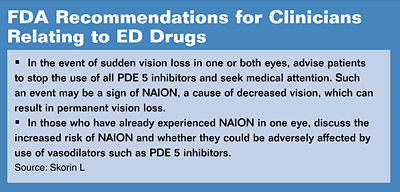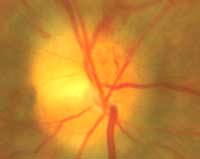Use of erectile dysfunction drugs may rarely cause optic neuropathy
The three Food and Drug Administration-approved erectile dysfunction (ED) medications, sildenafil (Viagra, Pfizer), tadalafil (Cialis, Eli Lilly) and vardenafil (Levitra, Bayer Pharmaceuticals/GlaxoSmithKline), have each been implicated in a number of different ocular changes, some temporary and benign and others permanent and visually devastating. The most recent debate has been whether these ED drugs cause nonarteritic anterior ischemic optic neuropathy (NAION).
ED widespread
Erectile dysfunction is a significant problem that, although not life- or health-threatening, can seriously affect quality of life. This dysfunction occurs not only in older men, but also in up to 7% of men ages 18 to 29. Overall, it is estimated that up to 30 million men in the United States, including half of all men ages 40 to 70, may be affected by ED.
Any disease process that can adversely affect an individual’s vascular, neural or endocrine systems can cause ED. These would include hypertension, hypercholesterolemia, cardiac disease, diabetes mellitus and depression.
To obtain an erection, nitric oxide is released in the corpus cavernosum of the penis. This activates the enzyme guanylate cyclase, which leads to a subsequent increase in the levels of cyclic guanosine monophosphate (cGMP). The nitric oxide-cGMP pathway relaxes smooth muscle in the penis, which in turn increases blood inflow and closes venous drainage channels. As the cavernous bodies become engorged with blood, the erection ensues. The enzyme cGMP-specific phosphodiesterase type 5 (PDE 5) then breaks down cGMP. This causes the erection to end.
The ED drugs are potent and selective inhibitors of the enzyme cGMP-specific PDE 5, which increases the intracellular levels of cGMP, thereby prolonging the smooth muscle relaxation and enhancing erectile function.
Associated ocular symptoms
|
Image courtesy of Consultant, Cliggot Publishing Group, CMP Healthcare Media. |
The most common visual changes associated with ED drugs are the development of a transient bluish or blue-green tinge or haze and a sense of increased light sensitivity and brightness. Although the ED drugs are very selective for inhibiting cGMP-specific PDE 5, PDE 6 is also inhibited. The PDE 6 enzyme is found in the rod and cone photoreceptors in the retina and, because it is involved in phototransduction, its inhibition is thought to cause the color and light sensitivity changes experienced by some individuals.
Other benign and transient ocular symptoms and signs include decreased color vision, dark colors appearing darker, blurred vision, central vision haziness, flashing lights, especially when blinking, temporary electroretinography (ERG) changes, conjunctival hyperemia, ocular pain and photophobia. Some of these findings, such as the ERG changes and color vision alterations, happen only if the patient has used higher doses of the ED drug. Visual acuity, visual fields, visual evoked potentials and intraocular pressure do not appear to be affected by these medications.
More visually significant and permanent defects have also been reported with the use of ED drugs. These are more unusual. They include pupil-sparing third cranial nerve palsy, central serous chorioretinopathy, serous macular detachment and retinal vascular accidents such as branch retinal artery occlusion.
Reports of related NAION
Recently, scientific reports have implicated the use of ED medications in NAION, a common acute optic neuropathy most often seen in older adults. Patients who develop NAION experience a sudden, painless, unilateral loss of vision that is most severe at the onset but may progress over the course of several weeks.
Funduscopy will show optic disc edema that is sometimes diffuse, but more often presents as sectoral involvement, accompanied by small flame-shaped hemorrhages and juxtapapillary arterial attenuation. These patients typically have a small, crowded optic disc with a small or nonexistent physiologic cup. This finding is known as a “disc at risk.”
Because the optic disc in the involved eye may be difficult to evaluate due to the accompanying swelling, the fellow eye should be examined. In most people, the optic disc anatomy is similar, and a more accurate assessment can be made of the uninvolved optic nerve head to see if it is a disc at risk. This would make the uninvolved fellow eye also at risk to develop NAION in the future.
The final visual acuity in these patients may range from 20/20 to light perception. Visual field defects classically present as an altitudinal or quadrantopic defect. An afferent pupillary defect is also usually present.
In most cases, patients experience no antecedent ocular or systemic symptoms. However, patients who develop NAION often have a history of vascular disorders such as stroke, myocardial infarction, hypertension, atherosclerosis, diabetes mellitus and hyperlipidemia. Smoking appears to also increase one’s risk in developing NAION.
Evaluation of NAION
Any patient with findings of NAION should have an erythrocyte sedimentation rate and C-reactive protein performed to rule out the arteritic variety, specifically temporal arteritis, of this disease process. If these blood laboratory values are elevated, a temporal artery biopsy is required to confirm the diagnosis of temporal arteritis. Temporal arteritis must be treated with systemic corticosteroids, while NAION has no known effective treatment.
FDA recommendations
In July 2005, the FDA called for updated labeling of all three ED drugs as a result of 43 post-marketing reports of sudden vision loss attributed to NAION in patients taking them. See the accompanying chart for clinician recommendations from the FDA.
NAION that results from the use of ED drugs may be caused by the transient decreases in systolic and diastolic blood pressure or a host of unforeseen side effects that can occur when other types of phosphodiesterase are inhibited.
If these drugs potentiate hypotension beyond the critical point at a susceptible optic nerve head (in a patient with vascular disease and a disc at risk), the autoregulation of ocular blood flow to the nerve may be severely compromised. If the perfusion to the nerve head drops sufficiently and for a long enough period of time, optic nerve head ischemia follows.
Pfizer, the manufacturer of sildenafil, states that in more than 100 clinical studies (more than 13,000 patients) of their drug, no cases of NAION were reported. They also state that more than 170 million sildenafil prescriptions have been administered to 23 million men (equivalent to 1 billion doses), so the overall occurrence of NAION is an extremely infrequent event.

Studies needed
In only one recent study (McGwin and colleagues), researchers found a statistically significant association between the use of sildenafil or tadalafil and NAION in men with a history of myocardial infarction and a significant association in men with a history of hypertension. Men with these conditions need to be especially warned about the increased risk in developing NAION.
Unfortunately, because of the lack of an animal model, a definite causal relationship cannot be established. Therefore, the FDA states that they “cannot draw a conclusion of cause and effect given the small number of events, the large number of users of PDE 5 inhibitors and the fact that this event occurs in a similar population to those who do not take these medications.”
For more information:
- Leonid Skorin Jr., OD, DO, FAAO, FAOCO, writes and lectures on ocular disease and neuro-ophthalmic disorders. He may be contacted at the Albert Lea Eye Clinic, Mayo Health System; (507) 373-8214; e-mail: skorin.leonid@mayo.edu.
Reference:
- McGwin G Jr, Vaphiades MS, Hall TA, Owsley C. Non-arteritic anterior ischemic optic neuropathy and the treatment of erectile dysfunction. Br J Ophthalmol. 2006;90:154-157

